Now she’s a ship – Honfleur’s hull and superstructure come together
-
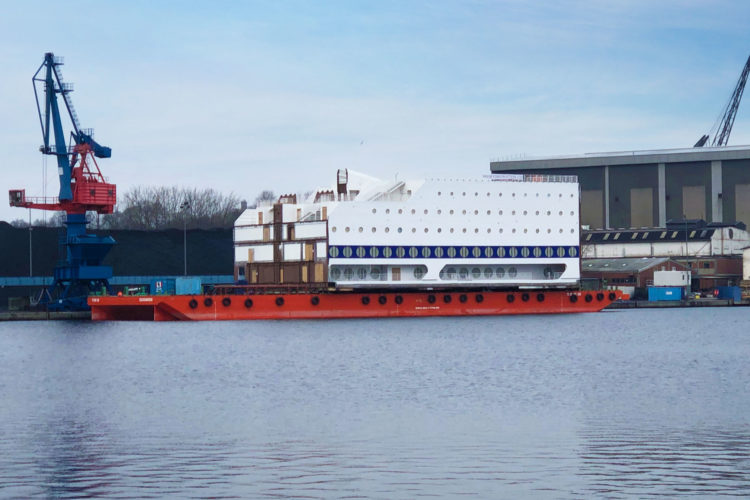 Honfleur lego build - aft block
Honfleur lego build - aft block
-
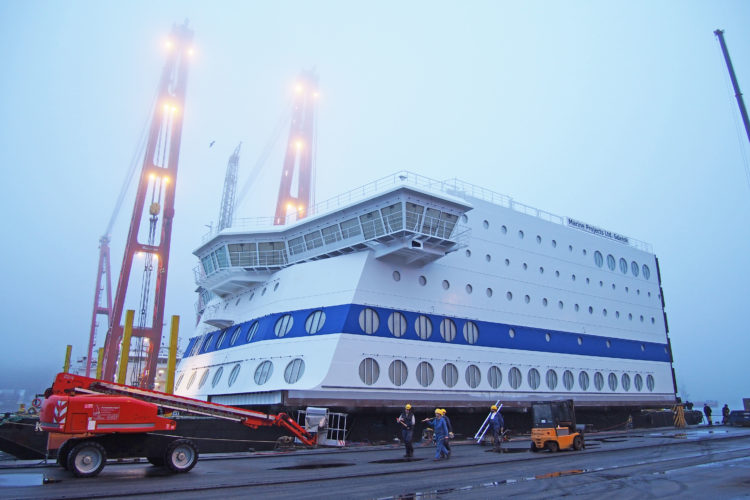 Honfleur lego build - bridge block
Honfleur lego build - bridge block
-
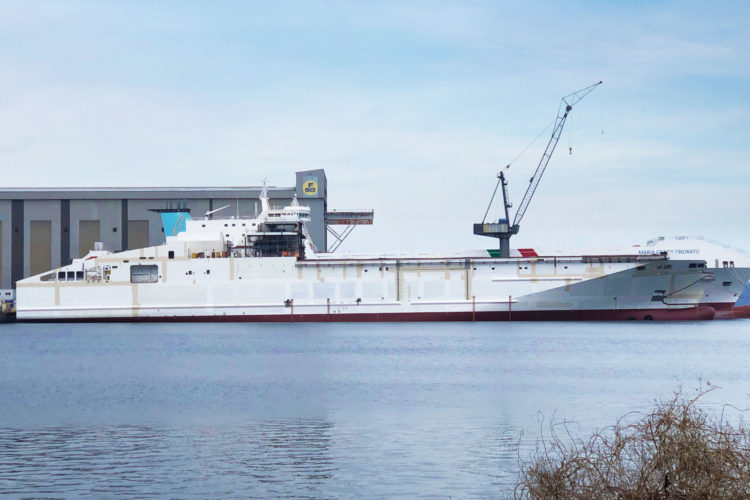 Honfleur's hull - launched 14 December 2018
Honfleur's hull - launched 14 December 2018
-
 Gulliver - the crane ship
Gulliver - the crane ship
-
 Lifting the aft block
Lifting the aft block
-
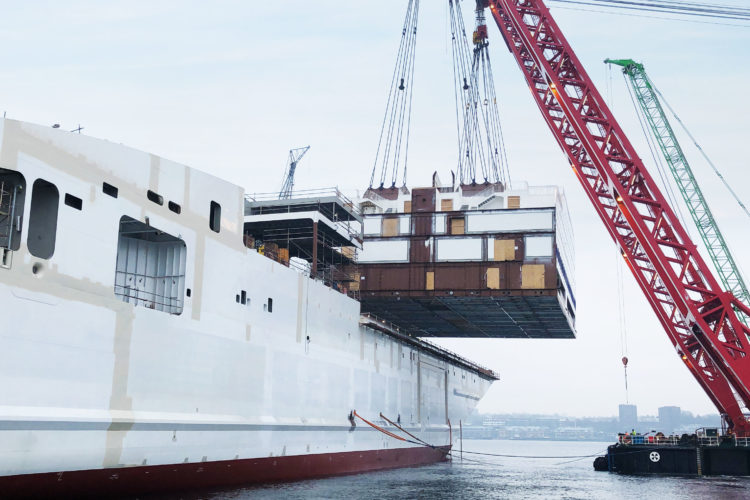 Placing the block on Honfleur's hull
Placing the block on Honfleur's hull
-
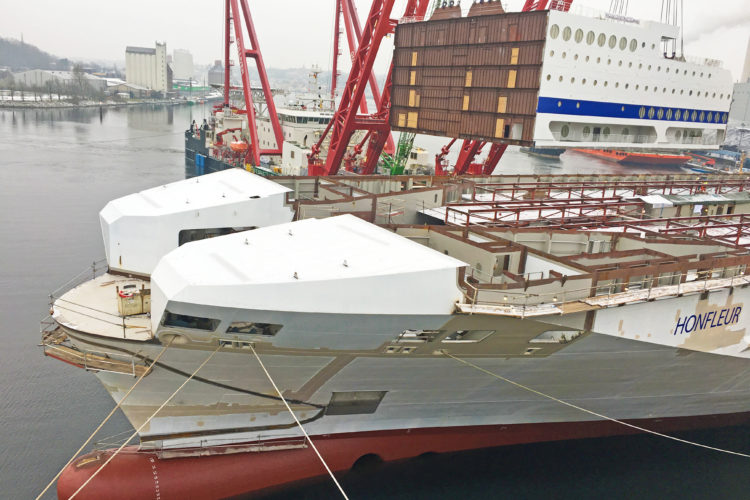 Easy does it!
Easy does it!
-
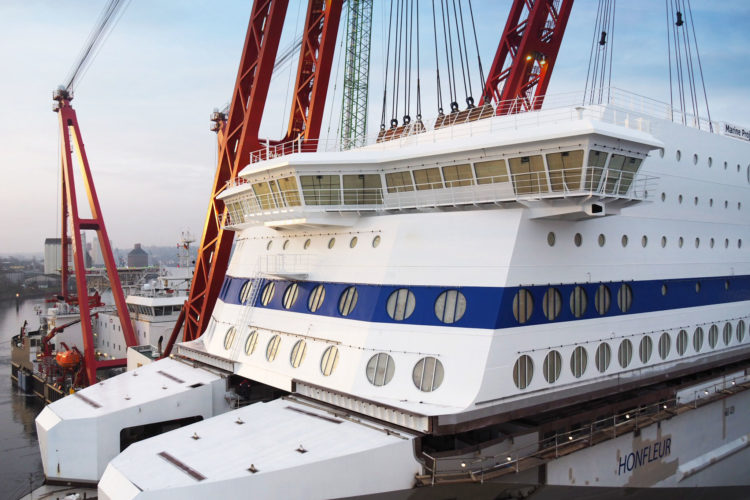 Forward block is set in place
Forward block is set in place
-
 Honfleur - dockside
Honfleur - dockside
Brittany Ferries’ radical new gas-powered ship Honfleur took a dramatic step closer to completion this week when almost her entire superstructure was craned aboard in two gigantic blocks weighing up to 2,000 tonnes each.
The spectacular operation marks the end of a milestone week in the cruise-ferry’s construction. Just days before the first block was lifted into place, crowds gathered to see Honfleur’s 10,000-tonne hull make the backwards slide down a slipway and into the Baltic Sea.
“In just seven days Honfleur has taken to the water for the first time, grown in height by around 20 metres, and acquired her distinctive profile,” said Christophe Mathieu Brittany Ferries CEO. “From here on, the story begins to move from the development of her innovative LNG infrastructure and hydrodynamic hull to focus on the richness of the passenger experience. This includes restaurants, cinemas, cafes and boutiques, as well as a range of digital and immersive spaces to be savoured on board.”
The giants of Gdansk
Each block is five decks high, over 40 metres long and spans Honfleur’s full 31-metre width. They house Honfleur’s airy public areas, her 261 passenger cabins and her bridge.
They were constructed in Poland’s historic Gdansk shipyards, which now also build luxury yachts and cruise liners, before being towed on barges to the FSG yard in Flensburg in northern Germany where her hull was built.
The blocks were placed on the hull by Gulliver, a 22,400-tonne heavy lift vessel operated by Scaldis. Delivered earlier this year, her twin cranes soar 100 metres into the sky, and are capable of lifting a 4000-tonne load to a height of 78 metres.
After picking each block up from its barge, thanks to sixteen cables attached to ‘grab handles’ welded to the top deck, Gulliver backed slowly away. She then turned towards Honfleur’s hull where blocks were inched downwards into position.
Each was placed with an accuracy of just a few millimetres, impressive given their huge size and weight, and the fact that the operation was carried out at sea. Work now begins to weld them into place, connecting pipework and cabling, as well as fitting and furnishing cabins and public areas.
“Lifting the deckhouses onto the hull like this looks dramatic, but there’s good business sense behind this process,” says Anna-Lena Bubenheim, project manager for Honfleur at the FSG shipyard.
“Constructing the hull and the upper decks separately and simultaneously is more efficient and cuts the build time significantly. It’s a tribute to the skill of our shipbuilders here at FSG, and to our partners and suppliers, that these huge sections fit together with millimetric accuracy.”
About Brittany Ferries
In 1967 a farmer from Finistère in Brittany, Alexis Gourvennec, succeeded in bringing together a variety of organisations from the region to embark on an ambitious project: the aim was to open up the region, to improve its infrastructure and to enrich its people by turning to traditional partners such as Ireland and the UK.
In 1972 BAI (Brittany-England-Ireland) was born. The first cross-Channel link was inaugurated in January 1973, when a converted Israeli tank-carrier called Kerisnel left the port of Roscoff for Plymouth carrying trucks loaded with Breton vegetables such as cauliflowers and artichokes. The story therefore begins on 2 January 1973, 24 hours after Great Britain’s entry into the Common Market (EEC). From these humble beginnings however Brittany Ferries as the company was re-named quickly opened up to passenger transport, then became a tour operator.
Today, Brittany Ferries has established itself as the national leader in French maritime transport: an atypical leader, under private ownership, still owned by a Breton agricultural cooperative. Eighty five percent of the company’s passengers are British. Around 210,000 freight units are carried each year.
Key figures:
- Turnover: Approximately €450m+ per year
- Employment – Between 2,400 and 3,200 employees (including 1,700 seafarers), depending on the seasonal nature of the activity. Approximately 6,000 indirect jobs
- Passengers: Between 2.5 and 7 million each year travelling in around 900,000 cars
- Freight 210,000 freight units and one freight only route linking Bilbao and Poole
- Ships: 11 vessels operating services that connect France, the United Kingdom, Ireland and Spain
- Ports: Eleven in total: Bilbao, Santander, Portsmouth, Poole, Plymouth, Cork, Caen, Cherbourg, Le Havre, Saint-Malo, Roscoff
- Tourism in Europe: 14.5 million nights generated in Europe including 9.4 million in France
Contact:
Christopher Jones on 02392 152 291 or 07917 540 878 or [email protected]
Nigel Wonnacott on 02392 152 273 or 07833 446 729 or [email protected]
 News
News